Calculating Link Budgets
|
|
Coaxial Connectors
The small metallic screw-on ends that terminate pigtails and other runs of coaxial cable are called coaxial connectors. There are probably close to a hundred different kinds of coaxial connectors used in radio work today and in times past, but only a handful are in regular use in the Wi-Fi industry.
Complicating the picture is the fact that most Wi-Fi connectors are used only in the Wi-Fi industry for Wi-Fi products, and are unknown in other sectors of radio technology. (The main exception is the ubiquitous N connector.) In this section I'll briefly describe the connectors you may encounter in Wi-Fi work.
Reverse-Polarity Connectors
One reason that Wi-Fi connectors are specific to the Wi-Fi industry is that the FCC would prefer that it be difficult for basement tinkerers (like thee and me) to connect Wi-Fi things in ways not explicitly tested and approved by the FCC. So in traditional government fashion, it decreed that Wi-Fi connectors used in consumer products like access points and client adapters be nonstandard. This hasn't made them especially difficult to obtain, but it has made them more expensive.
So that connector manufacturers wouldn't have to completely retool their equipment to make utterly new types of connectors, these nonstandard connectors were devised by flipping the sense of the plugs and the sockets on existing standard connectors. Traditionally, a male connector has a little pin protruding from its center, within a larger free-turning threaded metal sleeve. A female connector has a little springloaded cylinder into which the male pin slides to make electrical contact, set into a narrower threaded sleeve that does not turn. In reverse-polarity connectors, the FCC has mandated a sort of sex change, in which the female connectors now have a pin, and the male connectors now have the cylinder.
This is easier to show than describe (see Figure 8.11). I've drawn both normal and reverse polarity coaxial connectors in cross-section to show the reversal of the pin and the cylinder. Note that the figure doesn't depict any particular type of coaxial connector, but most of the microwave connectors you'll encounter in Wi-Fi work are constructed roughly the same way, and differ mostly in size. Male connectors are customarily used on the ends of coaxial cable runs, and female connectors are customarily used on the equipment itself.
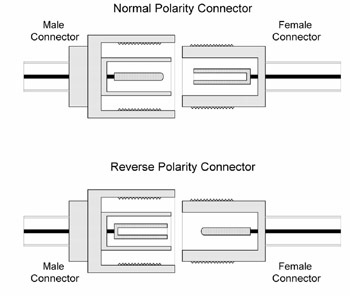
Figure 8.11: Normal and Reverse Polarity Connectors.
N Connectors
I've been told that the 'N' stands for 'Navy,' but the truth is that the 'N' is for Bell Labs scientist Paul Neill, who designed the connector for use by military (primarily Navy) radar equipment during World War II. N connectors are the largest of the Wi-Fi family of coaxial connectors, being about 3/4' in diameter. Most of the larger external antennas without integrated pigtails connect through female N connectors. The better N connectors are silver plated for lower losses. See Figure 8.12.
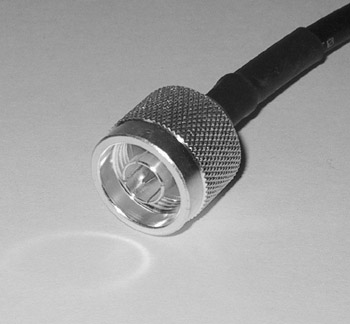
Figure 8.12: A Male N Connector on a Coaxial Pigtail.
MMCX Connectors
Several models of Wi-Fi PCMCIA Cards including the Cisco 350 series, allow for connection of an external antenna through a very tiny gold-plated connector called the Micro-Miniature Co-aX (MMCX) connector. The MMCX is the microminiature adaptation of the older Miniature Co-aX (MCX) connector, which is not used in Wi-Fi hardware to my knowledge. See Figure 8.13.
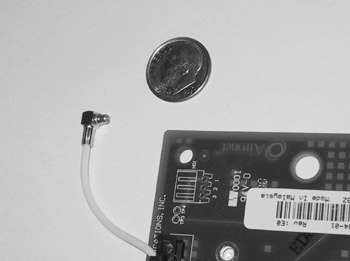
Figure 8.13: An MMCX Connector.
The older Cisco 340 PC cards lack this connector-except those cards built into the 340-series PCI bus cards, which carry the 342 model number. The connector in Figure 8.13 is shown with the Cisco Aironet PCI 342 client adapter of which it is a part, with a dime for scale. The v2.5 build of the Linksys WUSB11 USB client adapter also has an MMCX connector. (The newer v2.6 build of the WUSB11 removed the connector for reasons unexplained, and the v2.6 'Popsicle stick' antenna is non-removable.)
The MMCX is about the same size as the RMC connector used in Orinoco Silver and Gold cards, but unlike the RMC, MMCX is fairly common and easy to obtain 'loose' (that is, not bound into a pigtail). Still, its extremely small size makes it very difficult to work with, and if you need an MMCX connection, buy a commercial pigtail. (See Appendix A for a list of suppliers.)
RMC Connectors
The extremely popular Orinoco Silver and Orinoco Gold PCMCIA wireless LAN cards have a feature that many such cards lack: A jack for an external antenna. The jack, on the edge of the external 'antenna bulge,' is extremely small and easy to miss, since it is only about 1/8" in diameter and protected beneath a small button of black plastic that blends well with the rest of the bulge.
The tiny coaxial plug that connects to the jack is called an RMC connector. (I don't know what the acronym expands to.) Technically, it's the RMC-6010-B. This connector was originally haunted by distribution limitations imposed by Orinoco vendor Agere and was difficult for hobbyists to obtain, but since Agere was purchased by Proxim I've begun to see the connector offered without restriction by vendors like RF Parts. (See Appendix A.) I think Agere had been asked to restrict distribution by the FCC, which doesn't favor individuals fooling with Wi-Fi antennas.
Although there are now dealers who will sell single RMC connectors to hobbyists, it makes more sense to buy the connectors as parts of factory-configured pigtails, usually with an RMC connector on one end and an N female connector on the other. Soldering coaxial cable to the nearly microscopic RMC and MMCX connectors (microscopic to middle-aged eyes, at least) is agonizing, and most people don't have the skill or equipment to do it correctly. Bad coaxial connections introduce intermittent connections, shorts, and impedance bumps into the coax line, which increase the already appalling RF losses inherent in thin coaxial cable. To keep as much of your signal as possible, let the pros do it.
RP-SMA (Reverse Polarity SMA) Connectors
The RP-SMA connector is the reverse-polarity form of the existing standard Sub-Miniature A (SMA) connector. Many popular PCI card Wi-Fi client adapters (including those from Linksys and D-Link) use a detachable antenna mounted to the card spine, and this antenna attaches through an RP-SMA connector. See Figure 8.14.
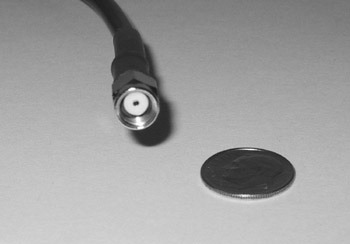
Figure 8.14: An RP-SMA connector.
You can buy pigtails incorporating RP-SMA connectors from Fleeman, Anderson, & Bird, among other vendors. Most such pigtails cost from $22 to $30. See Appendix A.
The RP-SMA connector, while not quite as microscopic as the RMC and MMCX connectors, is still very small and difficult to work with, and I do not recommend making up your own pigtails at home. If you insist, they are available from vendors like RF Parts. See Appendix A.
RP-TNC (Reverse Polarity TNC) Connectors
In the 1950's, Bell Lab scientists Paul Neill and Carl Concelman created a smaller version of Neill's WWII-era N connector, which became known as the Threaded Neill-Concelman (TNC) connector. The bayonet version of the Neill-Concelman connector is the well-known BNC (Bayonet Neill-Concelman) connector that was once ubiquitous in the old 10 Base-2 'Thin-net' Ethernet networks. The RP-TNC connector is the much more common TNC coaxial connector with a sex-change operation: Where you'd expect to find the prong you find the hole, and vise versa. Most wireless access points with removable antennas are fitted with RP-TNC (reverse polarity TNC) connectors on their back panels.
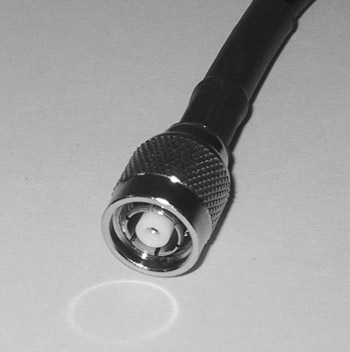
Figure 8.15: An RP-TNC Connector on a Pigtail.
RP-TNC connectors are reasonably sized, and it's possible to make up your own coaxial jumpers from raw cable and RP-TNC connectors. Typically, what you need is a jumper with an RP-TNC connector on one end and a male N connector on the other. Again, if you're not an ace at making up coax assemblies, resist doing it yourself. Bad solder joints will cost you more power and signal at 2.4 GHz than at lower frequencies, so if you possibly can, buy readymade assemblies. See the vendor list in Appendix A.
Coaxial Connector Losses
Because every coaxial connector in a signal path creates a slight disturbance in the path (that impedance bump I've mentioned here and there) each connector contributes some loss to the path. How much of a loss depends on the frequency and on the connector, but it amounts to about .2 to .5 dB per connector. Note that for this calculation, joined connectors (in other words, a male and female connected together) are considered a single connector.
This isn't well understood in the Wi-Fi world, and there's nothing you can do about it anyway, but coaxial connectors work best at microwave frequencies when the coaxial cable they're attached to is of an appropriate size. N connectors, for example, create a pronounced impedance bump when used with very small or very large coax.
Thin coaxial cable like LMR 100A works best with small coaxial connectors like the MMCX and RMC.
The whole idea in a coaxial connector is to create a radio energy path through the connector that duplicates as closely as possible the path through the coaxial cable to which the connectors have been attached. If the diameter of the path through the connector is of a different size than the diameter of the cable, an impedance mismatch occurs through the connector, which increases losses through the connector slightly. Again, you can't always dictate what connectors you use in any given application, but it's useful to know why connectors exhibit losses and what makes those losses worse in particular circumstances.
In truth, connectors don't contribute a lot of loss to your signal path unless you use a lot of them, but try to keep them to a minimum when setting up any Wi-Fi system.
Path Loss
As if there weren't enough factors eating your Wi-Fi radio signal, well, empty space eats it as well. Your signal gets weaker the longer it travels through open air. How much? The basic formulas are pretty simple. Path loss in dB may be calculated this way:
Lp = 32.4 + 20logf +20logd (d given in kilometers)
Lp = 36.6 + 20logf +20logd (d given in miles)
In both equations, f is given in MHz.
For Wi-Fi work at 2450 MHz, across a path one mile in length, we'd calculate:
36.6 + (20 X 3.38) + (20 X 0) = 104.2 dB
You lose 104 dB just by being a mile away! That sounds grim, but that's physics- and the loss is ameliorated by the gain in your antennas and the gain in the amplifiers in your Wi-Fi gear.
What is a little discouraging is that many more factors enter into path loss that aren't as easily calculated. Primary among these are reflections off level ground and various objects like buildings and hills, and incursions by obstructions into what is called the Fresnel zone, which is an ellipsoidal region surrounding the line of sight between your two Wi-Fi antennas. If you're comfortable with the math and would like to learn more, there is an excellent technical discussion on the Web at:
http://www.tapr.org/tapr/html/ve3jf.dcc97/ve3jf.dcc97.html
The paper is available in PDF format as well for easy printing.
|
|
EAN: 2147483647
Pages: 181